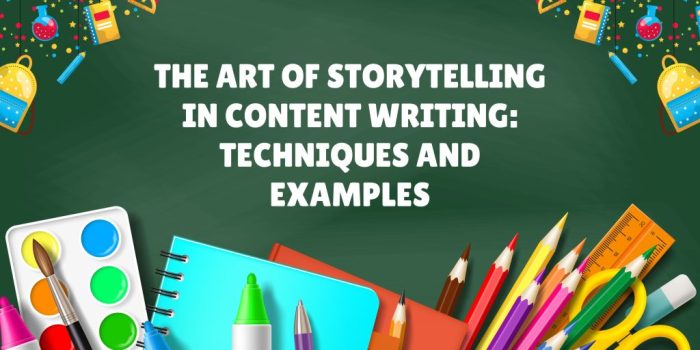Creating Content with Storytelling Techniques takes center stage, inviting readers into a world of creativity and captivating narratives. Get ready to dive into the art of crafting compelling stories that resonate with your audience!
In this guide, we will explore various storytelling techniques to help you create content that leaves a lasting impact and connects with your readers on a deeper level.
Introduction to Storytelling Techniques in Content Creation
Storytelling techniques in content creation refer to the art of using narratives, characters, emotions, and conflicts to engage and connect with the audience. It involves crafting a compelling story that resonates with the viewers, making the content more memorable and impactful.
Incorporating storytelling in content is crucial as it helps to capture the audience’s attention, evoke emotions, and create a lasting impression. By weaving a narrative into the content, brands can establish a deeper connection with their target audience, leading to increased engagement, loyalty, and brand recall.
Examples of Successful Brands Using Storytelling Techniques
- Apple: Apple is known for its iconic storytelling in marketing campaigns. Their ads focus on emotions, aspirations, and human experiences rather than just product features, creating a strong emotional bond with consumers.
- Nike: Nike’s marketing campaigns often feature powerful storytelling that revolves around themes of overcoming challenges, achieving greatness, and pushing boundaries. These stories resonate with athletes and inspire them to pursue their goals.
- Coca-Cola: Coca-Cola has mastered the art of storytelling through its campaigns that celebrate togetherness, happiness, and unity. Their commercials often feature heartwarming stories that connect with people on a personal level.
Understanding Your Audience

Knowing your audience is key when using storytelling techniques to create content. Understanding their preferences, interests, and needs allows you to tailor your message in a way that resonates with them on a deeper level.
To conduct audience research, start by analyzing demographic information such as age, gender, location, and income level. This data can provide valuable insights into who your audience is and what they might be looking for in your content. You can also use tools like surveys, interviews, and social media analytics to gather more specific information about their likes, dislikes, and behavior patterns.
How Audience Demographics Influence Storytelling Approaches
- Age: Younger audiences may prefer more dynamic and visually engaging storytelling, while older audiences might appreciate a more nostalgic or traditional approach.
- Gender: Gender can influence the tone, language, and themes used in storytelling, as different genders may relate to different types of content.
- Location: Cultural differences based on location can impact storytelling styles, requiring you to adapt your content to resonate with specific regions or communities.
- Income Level: Understanding the economic background of your audience can help you create content that aligns with their values and aspirations.
Crafting Compelling Narratives: Creating Content With Storytelling Techniques
Crafting a compelling narrative is essential in content creation as it keeps the audience engaged and eager to follow along. By using storytelling techniques effectively, you can structure your content in a way that captivates the reader or viewer.
Creating Characters, Conflict, and Resolution
To create a compelling narrative, start by developing interesting and relatable characters. Give them depth, flaws, and motivations that drive the story forward. Introduce conflict that challenges your characters and keeps the audience invested in the outcome. Finally, provide a resolution that satisfies the conflict and leaves the audience with a sense of closure.
- Characters: Develop unique personalities, backgrounds, and goals for your characters to make them memorable and engaging.
- Conflict: Introduce obstacles, challenges, or dilemmas that your characters must overcome to progress the story.
- Resolution: Ensure that the resolution of the conflict feels satisfying and logical based on the characters’ actions and development throughout the narrative.
Storytelling Elements
Incorporating storytelling elements like plot twists, foreshadowing, and cliffhangers can enhance the narrative and keep the audience on the edge of their seats.
- Plot Twists: Surprise your audience by introducing unexpected turns of events that challenge their expectations and assumptions.
- Foreshadowing: Hint at future events or outcomes to create suspense and intrigue, leading the audience to anticipate what will happen next.
- Cliffhangers: End sections of your content with unresolved situations or questions to leave the audience wanting more and eager to continue following the story.
Choosing the Right Medium for Your Story
When it comes to storytelling, the medium you choose can greatly impact how your message is received. Whether it’s through text, video, audio, or visuals, each medium has its strengths and weaknesses that can affect the way your story is perceived by your audience. It’s essential to carefully consider which medium will best convey your story and connect with your audience effectively.
Text
Text can be a powerful medium for storytelling, allowing for detailed descriptions and the ability to engage the reader’s imagination. It is great for conveying complex ideas and emotions through well-crafted writing. For example, a blog post or a social media post can be a great way to share a personal story or provide valuable information to your audience.
Video
Video is a dynamic medium that can capture the audience’s attention through visuals, sound, and motion. It allows for a more immersive storytelling experience, making it easier to evoke emotions and create a strong connection with the viewer. For instance, creating a vlog or a short film can help bring your story to life and engage with a wider audience.
Audio
Audio storytelling is a powerful medium that relies on sound to convey emotions and create a personal connection with the audience. Podcasts, audiobooks, or even music can be used to tell compelling stories and engage listeners in a unique way. By using only sound, you can create a more intimate and immersive experience for your audience.
Visuals
Visual storytelling uses images, graphics, and other visual elements to convey a narrative. It can be a highly effective way to communicate complex ideas quickly and engage viewers visually. Platforms like Instagram, Pinterest, or infographics are excellent mediums for sharing stories through visuals, making it easier to grab the audience’s attention and convey information in a concise and compelling manner.
In conclusion, choosing the right medium for your story is crucial in effectively conveying your message to your audience. By understanding the strengths and weaknesses of different mediums and tailoring your storytelling approach accordingly, you can create a more engaging and impactful story that resonates with your audience.
Evoking Emotions through Storytelling
Storytelling techniques have a powerful impact on evoking emotions in the audience. By incorporating elements like empathy, suspense, or humor, storytellers can connect with their viewers on a deeper level and elicit strong emotional responses.
Using Emotions in Storytelling
- Empathy: Creating relatable characters and situations can help the audience empathize with the story, making them more emotionally invested.
- Suspense: Building tension and anticipation keeps viewers engaged and emotionally involved as they eagerly await the resolution.
- Humor: Adding comedic elements can lighten the mood and create a positive emotional connection with the audience.
Examples of Emotional Storytelling Campaigns
1. Always #LikeAGirl Campaign: This campaign challenged stereotypes and evoked feelings of empowerment and confidence in young girls.
2. Google’s “Reunion” Ad: This emotional ad showcased the power of storytelling to evoke nostalgia and the importance of staying connected with loved ones.
3. Dove’s Real Beauty Campaign: By celebrating real women and promoting self-acceptance, this campaign resonated with audiences on an emotional level.
Measuring Success of Storytelling Content

When it comes to evaluating the success of storytelling content, it’s essential to look at key performance indicators (KPIs) that can provide insights into the effectiveness of your narratives. By tracking these metrics and analyzing the data, you can optimize your storytelling strategies for better engagement and impact.
Key Performance Indicators for Storytelling Content, Creating Content with Storytelling Techniques
- Dwell Time: Measure how long users spend engaging with your content. Longer dwell times indicate higher interest and involvement.
- Click-Through Rate (CTR): Monitor the percentage of people who click on a call-to-action or link within your story. A higher CTR shows effective storytelling.
- Conversion Rate: Track the number of users who take the desired action after consuming your story, such as signing up for a newsletter or making a purchase.
- Engagement Metrics: Look at metrics like shares, likes, comments, and follows to gauge the level of audience interaction with your content.
Tools and Methods for Tracking Storytelling Effectiveness
Google Analytics
is a powerful tool for monitoring website traffic, user behavior, and content performance. By setting up specific goals related to your storytelling content, you can track how users interact with your stories and make informed decisions based on the data.
Analyzing Data to Optimize Storytelling Strategies
Using tools like
Social Media Analytics
can provide insights into audience demographics, engagement patterns, and content preferences. By analyzing this data, you can tailor your storytelling approach to better resonate with your target audience and improve overall performance.












